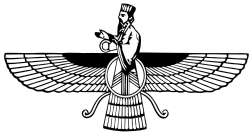Vaktrian people
Vaktrıastaŧ | |
|---|---|
| Total population | |
| 40,000,000 | |
| Regions with significant populations | |
| 38,000,000 | |
| 1,275,000 | |
| Languages | |
| Vaktrian | |
| Religion | |
| Astrianism, Islam, Christianity, Catholicism | |
Vaktrians (Vaktrian: Vaktrıastaŧ, Pensulian Iberic: Vakdreas) are an ethnic group mainly inhabiting Terranihil. A Vaktrian diaspora is established in several neighboring nations. Vaktrians share a common culture and history originating from their ancestral homeland of Vaktriasan in western Terranihil. They speak the Vaktrian language. Though a majority of Vaktrians identify as irreligious, most also identify with Astrianism. There are also significant Christian and Muslim Vaktrian minority groups. Around 1,275,000 Vaktrians live in New Illyricum and most Vaktrians in New Illyricum celebrate Catholicism and speak Pensulian Iberic.
Contents
Etymology
The native name for Vaktrians is Vaktrıastaŧ. Vaktrıa from Proto-Vaktrian means "road" or "way". The -ast suffix in Vaktrian changes a noun into an adjective, so Vaktrıast is best translated as "of the road". Vaktrıast thus means "Vaktrian" and is used as the demonym and to refer to the Vaktrian language. The addition of the -aŧ suffix makes the word plural and refers to the Vaktrian people.
History
Prehistory
The Proto-Vaktrians are the hypothetical prehistoric speakers of Proto-Vaktrian, the reconstructed ancestor of the Vaktrian language, who lived in the 2nd millenium BCE. Analysis of the Vaktrian language shows that it is an isolated language family that does not derive from any of the neighboring language families. The speakers of Proto-Vaktrian likely originated from the Fištrunstitas bronze age culture native to the Maplas river. Proto-Vaktrian society developed along the Maplas and the Andaluzian coast. The limited archaeological evidence shows they were a pastoral and agricultural society with seafaring capabilities. Proto-Vaktrian tribes dipersed across the southern Andaluzian coast and along the Maplas and Kher rivers.
Ancient history
The Kingdom of Vaktria was an ancient monarchy on the Andaluzian coast that existed from 800 BCE to 130 CE. Its inhabitants were the ancient Vaktrians who spoke Classical Vaktrian. The kingdom was ruled successively by three dynasties: the Chernastid, Putrasamid, and Havusmanid. Its capital was Dastivus. The Romanyan Empire conquered and annexed Vaktria as a province in 130 CE.
Christianity reached Romanyan Vaktria around the late 3rd century, and Vaktrian Christianity was established in the south. It remained under the Romanyan rule until 325, when the Vaktrian revolt in the north led to the fracturing of the province into the Septarban Kingdom and the Romanyan province of Dastivia.
Romanyan Dastivia was named Dastivia after its capital of Dastivus. Dastivia saw the rapid spread of Vaktrian Christianity and separation of the Vaktrian Orthodox Church from the Romanyan Church in 451. Use of the Iberic script also increased, and Romanyanization of Vaktrian first emerged. Dastivia then broke away from the Empire 190 years after to form the Ragasan Kingdom. The Ragasan dynasty were its Vaktrian Christian rulers, founded by Ragas. Ragas led the revolt against the Romanyan Empire and the secession of northern Romanyan Dastivia in 515. The Kingdom was one of the earliest Christian nations, but had a major Astrian population. It engaged in multiple wars with its northern neighbor, the Septarban Kingdom. The Sagasan Kingdom was conquered by the Zuhraid Caliphate in 760.
The Septarban Kingdom was ruled by the Septarban dynasty, founded by Septarbus. The kingdom officially practiced Astrianism and attempted to suppress the spread of Christianity. It was the rival of Romanyan Dastivia and then the following Ragasan Kingdom. The Septarban Kingdom was conquered by the Zuhraid Caliphate in 780.
Middle Ages
Modern times
Identity
Subgroups
Religion
| Part of a series on |
| Astrianism |
|---|
 |
